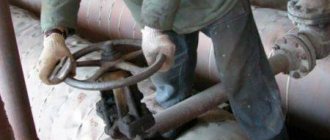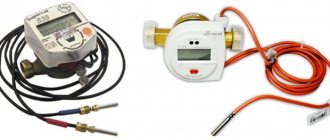Legislation in the field of electricity provides for the use of several types of tariffs for electricity transmission services.
In addition, probably every power engineer at an enterprise has at least once heard the terms “boiler from above”, “boiler from below”, “boiler holder”. At the same time, it is often unclear how electricity consumers depend (and whether they depend at all) on these “boilers” and why different tariffs are needed if they pay for electricity transmission services only one at a time. Let's figure it out.
Boiler pricing is used to determine tariffs for services for the transmission of electrical energy and the application of these tariffs in settlements between electricity consumers and network organizations, as well as between network organizations.
Its essence boils down to the following:
Before the start of the calendar year, the executive body in the field of state regulation of tariffs of the subject of the federation (REC of the region) collects proposals on the size of prices (tariffs) from the network organization. From these proposals, containing the necessary gross revenue (GRR, the amount of money needed by the network organization to conduct activities), the required gross revenue of the region is formed. This is the so-called boiler.
In order for the boiler to fill, the regional energy commission calculates and approves unified (boiler) tariffs broken down by voltage levels (HV, CH1, CH2, LV). All consumers of the same voltage level in the region pay for electricity transmission services at the same tariffs, regardless of which grid organization they are connected to and how many grid organizations are “on top”.
Next, the question arises of how to divide this pot between network organizations and who will fill it, that is, receive money from consumers.
There are several options:
Boiler from above
In the region there is a boiler holder - a network organization that enters into contracts on its own behalf with all consumers (or guaranteeing suppliers and energy sales organizations representing their interests), regardless of which network organization the consumers are connected to. Usually the boiler holder is a branch of IDGC.
The boiler holder collects all the money, and then distributes the share due to other network organizations operating in the region to them.
Settlements between grid organizations are carried out according to individual tariffs for electric energy transmission services , which the Regional Energy Commission of the region calculates based on the required gross revenue of grid organizations.
In the boiler-on-top scheme, tariffs are calculated so that the boiler holder transfers all of their NVV to adjacent network organizations.
This scheme is beneficial to the boiler holder. Related network organizations receive money on a residual basis. If there are non-payments on the part of consumers of transmission services (and they always exist), the boiler holder first “satisfies his appetite” and then transfers the money to adjacent network organizations.
Boiler from below
The opposite situation is when consumers (suppliers of last resort, energy sales organizations) enter into an agreement for the provision of electricity transmission services with the network organization to whose networks the consumer is connected. Next, the network organization transfers the money to a higher-level network organization. Individual tariffs for settlements between network organizations are set in such a way that network organizations transfer “upward” the difference between the money collected from consumers at unified (boiler) tariffs and their required gross revenue.
The implementation of such a scheme naturally benefits network organizations whose networks supply consumers with power. In this case, the IDGC branch receives part of the money last.
Consumers powered by IDGC networks, in principle, do not care what boiler generation scheme is used. In any case, they enter into an agreement and pay for electricity transmission services to IDGC.
Mixed boiler
Some network organizations in the region operate according to the boiler-on-top scheme, while others operate according to the boiler-on-bottom scheme. Mixed boilers arise when the boiler from below does not allow the redistribution of funds received from consumers in such a way that all network organizations receive their RRR.
Boiler on the side
Today, an already extinct type of boiler tariff formation, when the boiler holder is the supplier of last resort.
You will learn about current changes in the Constitutional Court by becoming a participant in the program developed jointly with Sberbank-AST CJSC. Students who successfully complete the program are issued certificates of the established form.
The program was developed jointly with Sberbank-AST CJSC. Students who successfully complete the program are issued certificates of the established form.
Document overview
Document overview
In relation to the case of payment for electricity transmission services, the Judicial Collegium for Economic Disputes of the Supreme Court of the Russian Federation noted the following.
Monogrids have been removed from the boiler model of payment for services. A monoconsumer whose power receiving devices are connected to monogrids must pay for electricity transmission services to the monogrid at the tariff established for it. If territorial grid organizations are also used to transmit electricity to this consumer, then their services are paid by the consumer to these network organizations at a single boiler tariff.
Within the framework of the boiler model, the consumer orders the “delivery” of electricity to his energy receiving device from one contractor, who transports it both independently and with the involvement of other network organizations. In this case, the place of fulfillment of the network organization’s obligations to provide services is the delivery point located on the border of the balance sheet of the consumer’s power receiving device and the networks of the last of the network organizations involved in the transmission. Either this will be the point of connection of the consumer’s power receiving device to an ownerless network or power grid facility of a person who does not provide electricity transmission services.
Outside the framework of the boiler model, each network organization from those whose networks are sequentially involved in the transmission of electricity to the end consumer participates in legal relations with it independently within its network section. Consequently, the scope of services of intermediate network organizations participating in the transmission chain must be determined at the point of connection of adjacent networks. In this case, the service delivery point will also be located there. Services are paid according to tariffs established for each network organization, for the volume of services provided by each of them.
Soon there will be no “cameras in the bushes” in the Tyumen region
Complete check of Tyumen drivers postponed due to rain
August 1: waiting for changes
How to choose a top combustion boiler
Due to the small selection, when all are worthy, there are no special criteria by which boilers can be filtered. Almost all models have a similar design, are often made of similar alloys, and both have a long history of trouble-free operation. However, it is worth paying attention to the most important criteria:
- Heat exchanger material . There are two versions: steel and cast iron. Steel heat exchangers are installed in cheaper models; they are more resistant to temperature changes; in case of mechanical damage, they can simply be welded. However, steel is highly susceptible to corrosion, which, depending on the quality of the coolant, leads to leakage after 10-15 years of operation. Cast iron heat exchangers are heavier and thicker, they are resistant to corrosion, their service life is more than 25 years, but the cost is corresponding. The ideal version is a cast iron heat exchanger in a light steel casing.
- Number of circuits . Single-circuit models are designed exclusively for heating. Double-circuit models are designed for heating and heating sanitary hot water. Their cost is only 10-30% higher, so it is most profitable to solve the issue of hot water supply by choosing a double-circuit boiler. The only problem is that among top combustion boilers there are very few double-circuit models.
- Efficiency . The efficiency factor reflects the ratio of the volume of fuel burned to the volume of thermal energy accumulated by the coolant. Accordingly, the higher the efficiency, the more heat can be obtained with less fuel consumption.
- Energy independence . Non-volatile models do not require connection to the mains, so they work autonomously. Volatile models have forced air supply, more complex automation or a circulation pump, the operation of which requires a connection to the electrical network. At the same time, we recommend purchasing a generator in case of a power outage.
The Nedelka K-60 model is an example of significantly larger dimensions.
Minimum required power
For an average house in the climatic zone of the Moscow region, with a masonry of 2 bricks and a ceiling height of 2.7 m, the minimum required power is calculated from the rule of 1 kW for every 10 m2 of heated area. We also recommend keeping a power reserve of 15-25%.
For example, for the house described above with an area of 120 square meters. m. the minimum required boiler power is 120:10 * 1.2 (20% reserve) = 14.4 kW, we always round up - i.e. 15 kW.
Such simple and most commonly used calculations are sufficient in more than 90% of cases. If the house is slightly or seriously insulated, is located in the southern part of the country or, conversely, is located in the northern part of the country, has a large glazing area, the indicator can be adjusted by 10-50% down or up.
How to accurately calculate the required boiler power Individual calculation, formula and correction factors
Where are they used?
Long-burning solid fuel boilers are used for heat supply to municipal, industrial, commercial and public facilities. The installation conditions for such modifications of heating boiler houses are much simpler than gas ones and do not require special permits.
However, they require the installation of a separate combustion and fuel storage room so that the coal or firewood is dry before being fed into the firebox.
To generate thermal energy, long-burning boilers can also use wood waste, briquettes and pellets.
Depending on the size of the firebox, fuel is added to the unit once a day, and some modifications once every 3 days. If there is a bunker fuel supply, the loading process can occur automatically. Boilers can provide not only the heating load, but also hot water supply with the inclusion of an external indirect heating boiler in the circuit.
Prices: summary table
| Manufacturer and model | power, kWt | Combustion chamber volume, l. | Efficiency, % | Cost, rub. |
| Stropuva S15U | 15 | 217 | up to 90 | 101 000 |
| LIEPSNELE L20U | 20 | 320 | before | 110 000 |
| Galmet TOP-20 | 20 | 45 | up to 87 | 90 900 |
| WEEK KO-60 | 60 | 160 | up to 92 | 130 000 |
BoilersLong burning boilersSolid fuel boilers
The better way to heat
The most important advantage of using solid fuel boilers is their versatility in terms of fuel used: firewood, briquettes, pellets and coal.
When choosing a fuel, you need to proceed from its calorific value:
- coal, 15-25 MJ/kg;
- firewood, 15-17 MJ/kg;
- wood pellets 12-17 MJ/kg.
It is equally important when choosing fuel to take into account its combustion time in the firebox. When using firewood and briquettes, the average operating time of the boiler on one refill does not exceed 30 hours. At the same time, using pressed pellets, it is capable of heating a house for at least 72 hours.
High-tech automated coal-fired boilers can heat rooms for 5 days or even more, which significantly increases the practicality of using such units.
Today, combined modifications powered by both solid fuel and electric heating elements are especially popular.
Such thermal power equipment is characterized by practicality, versatility and easy operation. Firewood or coal is used as the base fuel, and in their absence, heating elements are turned on, which ensures the required temperature in the house.
Is it profitable to buy a floor-standing boiler or not?
There is only one reason why a residential property owner might need to purchase a floor-standing gas boiler. This is poor light conductivity and constant interruptions. In this case, you need to think about purchasing a floor-standing boiler with a conscious understanding of the high gas consumption.
In all other cases, it is best to buy a wall-mounted boiler and use it. You can also ensure an uninterrupted power supply system by installing an inverter with a battery and connecting it to a wall-mounted gas boiler.
A floor-standing gas boiler is significantly inferior to a wall-mounted boiler in its characteristics. Today, it is much more economical and practical for the owner of a large private house to use a wall-mounted gas boiler without overpaying for the installation of a chimney. And the process of creating a cozy and warm atmosphere in the room will become simple and accessible.
Causes and provoking factors
The main reasons that can form a leak in a gas boiler are:
- Hole in the water heating tank – is caused by metal corrosion, which especially often affects those units that have been in continuous operation for more than 10 years. With frequent contact of water with a metal surface, rust forms, which gradually corrodes the water heater. At first it will be the smallest hole, which will not make itself felt for the time being. But at one fine moment a hole
will reach impressive sizes that cannot be missed with the naked eye. - Poorly tightened fittings and lack of tightness at the joints - water will constantly leak, forming drops that very quickly develop into puddles. This once again emphasizes the importance and necessity of proper installation of the heating system.
- A hole in the water heater along the weld seam - a manufacturing defect is difficult to check or identify before purchasing equipment. Usually the problem occurs exactly when the warranty period has expired. It is almost impossible to prove anything in such a situation, but you will have to spend money on expensive repairs or replacement of this part of the boiler.
- Burnout of the walls of the water heater - this is possible if there is a constantly strong flame in the combustion chamber, which, with frequent exposure to the metal, destroys its integrity. Naturally, this will not happen in a week, but over 10 years of continuous operation it is quite possible.
Don't forget about the problem of condensation. It often collects on metal pipes or plastic pipes, forming fairly large drops that supposedly flow out of the boiler.
This is all due to the lack of proper temperature in the room where the boiler is located. If it is below 10℃, and in the heating system the heating of water reaches 60-70℃, a temperature difference is formed, which is the cause of false concern.
Expert opinion
Grebnev Vadim Savelievich
Heating system installer
Naturally, the problem needs to be solved, since high humidity plus metal always equals corrosion, which will lead to the need to replace individual elements of the system.
Now let's look at the provoking factors that together lead to a malfunction of the water heater itself in the heating system:
- The boiler works “to wear out” - the maximum temperatures are set, the flame in the burner literally burns the metal, forming perforations in it.
- The boiler model was chosen incorrectly , the power of which is not designed to heat a huge area of housing. This happens when, in order to save money, for heating private residential buildings, not powerful wall-mounted boilers are purchased, but low-power (7-8 kW) parapet boilers. The result is clear - crazy excessive consumption of fuel and the boiler is working to the point of wear and tear, which threatens constant breakdowns.
- The combustion chamber is installed so low that the high flame of the burner destroys the metal layer.
Consequences of a leak in the boiler
- Using “living” water – water from wells and springs cannot be poured into the heating system, since a large amount of oxygen is dissolved in it. In turn, oxygen provokes the development of corrosion, which will cause leaks not only in the radiators, but also in the boiler itself. Experts recommend pouring only distillate into the expansion tank, but many users of gas equipment ignore this and install automatic make-up from the general water supply system.
- A sharp change in water temperature - when the system has completely cold water and the burner flame is set to maximum. The sudden heating of water leads to rapid expansion of the metal, which provokes cracks, especially in steel floor-standing boilers.
- Lack of annual preventative cleaning of the heating element - a reagent is introduced into the system that dissolves scale and also neutralizes rust in the water. If this is not done, the risk of developing a leak will be high already in the 3rd year of operation of the boiler.
Another important point is the cheap cost of the boiler. Imaginary savings that are achieved through the use of sheet metal that is prone to rapid oxidation with constant contact with the aqueous environment.
The reason for the formation of leaks on the downpipes is incorrect installation. More often this occurs when the installation of a heating system is carried out independently, without skill and experience.
Do not exclude such a problem as starting a heating system without coolant. The metal quickly overheats and is prone to cracks, chips and other damage.
Before starting the heating system, always check the presence of water and monitor the pressure. Start warming up with minimum temperatures, constantly increasing the degrees.
Cold welding
The leak area should be thoroughly dried and cleaned. After this, quickly knead part of the plastic mass with your hands and apply it to the hole so that the diameter of the patch is 2-3 cm larger than the diameter of the through hole. Let it dry for a day, then install the water heater in the boiler and run the system at minimum temperatures
Advantages:
- quick and easy hole repair
- you can solder several perforations at once, including seams
- relatively cheap repair method
Flaws:
- takes time to dry completely
- Not suitable for all types of boilers
- does not work if the boiler operates at high pressure and high temperature
- there is no guarantee that the boiler will not leak in the future
Semi-automatic welding
Semi-automatic welding
The holes are cleaned and dried, after which seams and points are applied to the thinnest areas of the metal structure. Next, the seams are sanded, rubbed, and the water heater is installed in the heating system and filled
Advantages:
- the work takes about 15 minutes
- high strength and reliability
Flaws:
- not suitable in all cases
- Need help from a specialist and equipment
Complete tank replacement
If the old one, after all the methods of eliminating the leak, does not hold water under pressure, then it is better to replace it with a new one. The process consists of purchasing a similar water heater and installing it in its original place
Advantages:
- full guarantee of no leaks in the future
- you can do the installation yourself
Flaws:
- Spending on new equipment
To get maximum confidence in the quality of the work performed, it is better to entrust it to specialists. They will not only quickly find the cause and eliminate it, but also give a guarantee.











